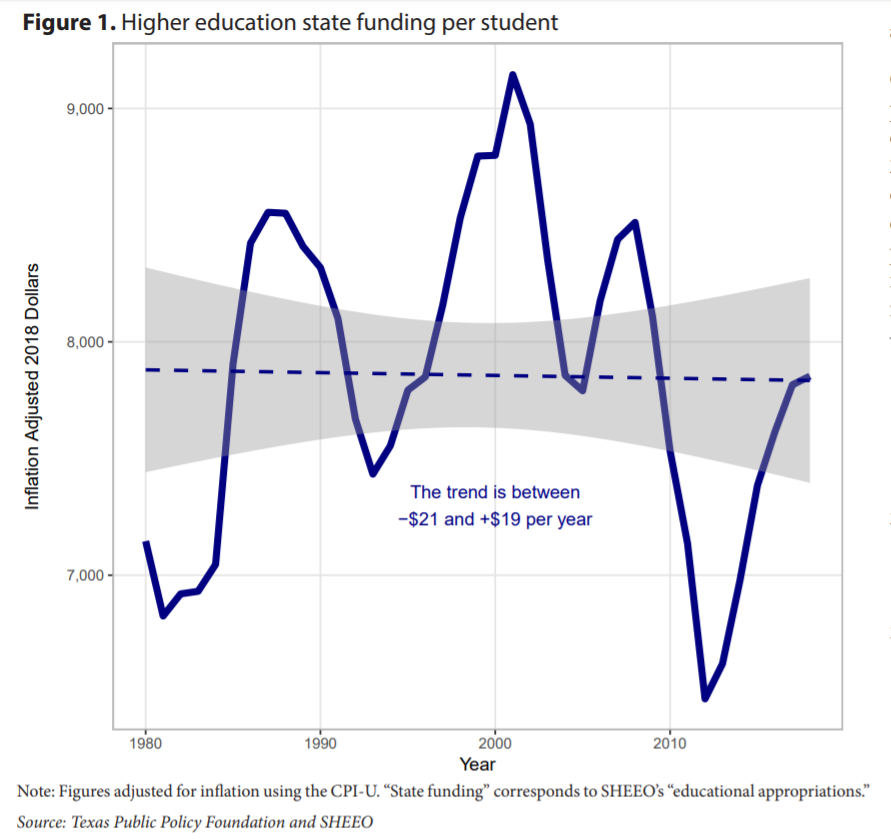
I have a confession to make. My recent study on state funding of higher education was about the simplest piece of research I’ve done in a dozen years. So was the finding; there’s been no trend of state disinvestment in higher education. But what a ruckus it caused.
The key finding entailed simply downloading and graphing data compiled by the State Higher Education Executive Officers Association (SHEEO). The data (shown in figure 1 of the report) showed that there is no trend in per-student state funding for higher education over the 38 years for which there is data (the statistical evidence indicates that there is a slight decline between a decline of $21 and an increase of $19 per student per year. Since this includes the value of $0, the standard interpretation is that there is no statistically significant trend, meaning there has not been a long-term trend of state disinvestment).
Prior to publication, I worried that the study would be ignored because the result was so blatantly transparent it was already widely known and acknowledged. So, imagine my surprise that it has been repeatedly challenged.
I’ve already responded to the two more reasonable challenges in a piece for the James Martin Center for Academic Renewal. To recap, the Center on Budget and Policy Priorities reaches a different conclusion by using 10 years of data rather than the 38 years I used, and SHEEO reaches a different conclusion by using an unorthodox price index that doesn’t actually correct for inflation. While I don’t agree with either, both are respectable positions to take so long as they are done transparently, which both were.
But the criticism of my study didn’t stop at the defensible, and the latest batch leaves me feeling like I’m being gaslighted.
A third criticism was lodged by F. King Alexander, then President of Louisiana State University, writing at Inside Higher Education.
Alexander’s first complaint is that I erred in following standard operating procedure by using the CPI-U to correct for inflation. He advocates for the Higher Education Price Index (HEPI), a price index so riddled with flaws no economist has used it for this purpose in years, probably decades.
Alexander’s next criticism is that state funding as a percent of state wealth has declined. This does nothing to refute my contention that the level of state funding has been fairly stable for 38 years (one of the conclusions of my report was that “Outside of recessions, state funding has typically been
between $7,400 and $8,400 per student per year for 38 years.”). If state funding for higher education is stable, and incomes are growing, then both sets of facts can be correct.
As misguided as they are, Alexander’s criticisms look quite rigorous compared to the critique offered by Derek Newton, writing at Forbes. Newton asks, “Why anyone would publish a piece so easy to disprove”—and then he utterly fails to disprove it.
He starts by attacking the organization I work for, which is a huge red flag in scholarly arguments where attempts are made to avoid the ad hominem fallacy.
He then warns us that he “did not major in math” and proceeds to prove it by thoroughly misinterpreting my results. My analysis shows that since 1980, state funding increased by $707 per student. But I also argue that a regression analysis provides more accurate trend detection than beginning and endpoint comparisons since it is not as influenced by possibly nonrepresentative starting and ending dates. So, rather than use the real 1980 value, a regression line essentially creates a hypothetical 1980 funding level, in this case, one that is substantially higher than the true funding in 1980. Measured from this hypothetical 1980 spending level, state funding changed by -$21 to +$19 per student per year, with a non-statistically significant point estimate of -$1.20.
In other words, there are two defensible conclusions from my analysis: since 1980, 1) there is an upward trend in state funding (using the actual historical data), or 2) there is no trend (using the regression results). Newton manages to avoid either of these inconvenient conclusions and unwisely stakes his claim of state disinvestment on the point estimate of -$1.20, apparently not realizing that it is non-statistically significant and that his follow-on calculations start from an artificially elevated level of funding in 1980. For good measure, he also gets some percentage calculations wrong.
Newton then argues that my analysis was flawed because I included too much data. Instead of starting in 1980, he wants to start in 1990, 2000, or 2008, because starting from those dates would all show disinvestment. But if shorter is better, why not start from 2012? Probably because that would show massive reinvestment in higher education (a 20% increase in per-student funding).
Newton’s next criticism is that even if funding has been flat, “we expect colleges to do way more than they did then.” Given trends in student study time and learning outcomes, that’s debatable. But it is also irrelevant to my paper, which is concerned with documenting whether funding has been flat, up, or down. Once we can get folks like Alexander and Newton to acknowledge basic facts like “the statistical evidence indicates there has been no trend of state disinvestment in the past 38 years when using the most commonly used price index to correct for inflation” then we can start talking about whether that fact is a good or bad thing. But, as Newton writes,
“For reasons passing understanding, some people simply refuse to believe facts and are oddly invested in shouting them down. So, frustrating as it is to have to back up and start with actual evidence, it’s occasionally required.”
I couldn’t agree more.

By any reasonable measure, state funding per student has declined. Sure, if you take 1980 as your starting point — after a decade of ruinous inflation that hammered college budgets — you can reach the conclusion that things have not changed. But then when you factor in much higher professional salaries, vastly higher health insurance costs, you find that the public colleges have fallen way behind. Compare to K-12 funding per student, which has approximately doubled since 1980 (after inflation). Imagine running your local public schools for half what they currently get, and you are back in 1980. Or imagine taking medical expenditures back to 1980 levels. Propose either of these as public policy and see what the reaction is.
Andrew Gillen’s organizational affiliation may be more or less irrelevant, but it has always seemed to me that he and his mentor Richard Vedder have an ax to grind. I take everything they say with a huge block of salt.
Okay, go back to 1950 as a baseline — before both Vietnam and the inflation resulting from it.
You will find a lot fewer people on the payroll, paid a lot less, and working a lot harder. The Tuesday-Thursday classes used to also meet on Saturdays. The professor teaching one class a year (eg Liz Warren) was teaching eight advising students as well.
There is a very big difference between the level of state support and the institution increasing its overall spending so as to reduce the percentage of that state allocation in the overall University budget.
Likewise, if you wish to argue that states should increase their support for state colleges, then do so. But please be intellectually honest enough to admit that there hasn’t been some massive cut in state aid.
Ed, sure, let’s go back to 1950. We could run the schools, k-12 for one fifth of what they cost today. Or better yet, 1850.
In fairness, I would have started with either 1975 or 1985 because 1980 was when the baby boom generation was aging out of college and you want your baseline to either include them or exclude them.
That said, I’m neither surprised at the results nor at the response to them. For the past 40 years, the mantra has been the college is expensive because of legislative budget cuts and not the increased college spending. The Pioneer Institute has shown this relative to UMass, with the allocation increasing but the spending increasing even more.
I’d like to see 1950 used as a baseline because that’s when professors taught eight classes a year, including on Saturdays. It’s not just that administrative now outnumber professors, but the professors are now teaching as few as two or three classes a year. Of course that’s going to increase expenses….
Hence it’s entirely possible four state appropriations to remain constant (or increase) while the percentage of the University budget provided by the state decreases — it’s what happens when you spend like drunken sailors and then the balance your budget on the backs of you students.
The other thing to remember is that there is state funding of public universities outside of the line item appropriation.
In most states, university employees come in under the state pension plan — in Massachusetts that’s 80% of your three best years, for life. And what no one’s talking about is that includes the 16,000 Mass state employees being paid six-figure salaries — the majority of whom are in higher education.
The Commonwealth is on the hook for those pensions and for all of the building bonds and numerous other things that aren’t part of the actual budget line. None of this ever gets mentioned when the universities claim that they’re not being give enough money by the state.